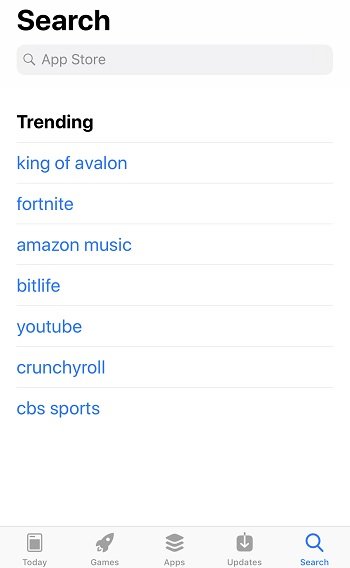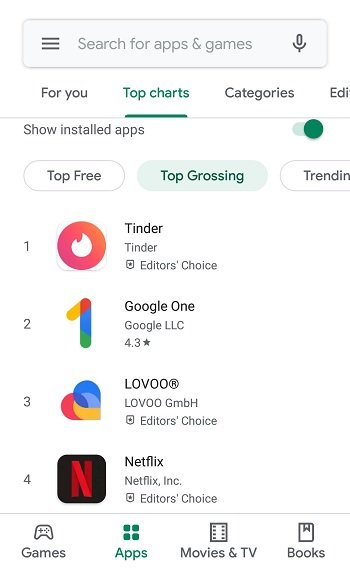With more than 1.8 million iOS apps on the App Store and more than 3 million Android apps on the Google Play Store, the competition for users is enormous. And as this number raises constantly, it gets harder and harder to acquire new users by doing App Store Optimization. Therefore, some app owners turn towards Black Hat ASO.
WHAT IS BLACK HAT ASO?
Black Hat ASO is a collective term for a set of measures to manipulate the app stores’ algorithms and generate more organic downloads. “Normal” App Store Optimization (also called “White Hat ASO”) has two goals: increasing an app’s visibility in search results and top charts, and optimizing the conversion rate of users who visit the product page. All White Hat measures are performed in compliance with the guidelines of Apple and Google. App owners who use Black Hat measures have the same goals, but in contrast, they violate these guidelines and create unfair advantages for themselves.
Here is a list of black hat measures:
- Keyword Stuffing
- Buying Search Traffic
- Targeting Trending Keywords
- Targeting Competitors’ Brand Keywords
- Buying Bot Traffic
- Manipulating Top Grossing Charts
- Buying Reviews
- Faking Social Proof
- Copying Competitors’ Assets
As Black Hat ASO violates the app store’s guidelines, using them can result in a ban of your app. Thus, I suggest that you DO NOT USE BLACK HAT ASO. To make sure, you do perform any forbidden actions, read on and learn more about them.
KEYWORD STUFFING
Store: Google Play Store (Android)
Target: Search Results
Getting an app into search results is a rather easy way to generate more organic downloads. Even new apps can make it into SERPs without the need of spending money. Thus, SERPs are a popular target for Black Hat attacks.
On Google Play, the app description is indexed. That means that it can contain up to 4,000 characters of keywords. As an honest app marketer, you would make the description a good read with proper grammar and implement your keywords in a meaningful way. But Black Hat marketers do not care about grammar or readability. They would simply stuff as many keywords as possible in their app descriptions.
This strategy is called keyword stuffing. It was very common in the past, but nowadays you will come across stuffed descriptions rarely on Google Play. In the App Store, this Black Hat approach was never useful because the iOS app description is not indexed by the algorithm.
BUYING SEARCH TRAFFIC
Store: App Store (iOS), Google Play Store (Android)
Target: Search Results
Another way to manipulate search is to buy search traffic. If many users search for a specific keyword and then download a specific app from the search results, the algorithm will consider this app extraordinarily relevant to the keyword. As a result, this app will climb up the SERP.
Black Hat marketers pay users for performing exactly these actions. Without a doubt, that is a punishable strategy according to the App Store and Google Play Store guidelines.
TARGETING TRENDING KEYWORDS
Store: App Store (iOS)
Target: Search Results
When you navigate to the search form in the App Store, you will see a list of trending keywords. These are terms that many users have searched for recently.
This list is another target of Black Hat ASO measures. Some app owners use the words on this list as keywords on their app’s product page. They hope to push their app onto the popular keywords’ SERP and generate additional organic downloads by doing so.
In general, there is no problem with this strategy, given that the trending keywords are relevant to the app. But if the keywords and the app have no connection whatsoever, this approach is a violation of the App Store’s guidelines.
As Google does not provide a list of trending keywords in the Google Play Store, this strategy only affects SERPs for iOS apps.

Trending Keywords on the App Store
TARGETING COMPETITORS’ BRAND KEYWORDS
Store: App Store (iOS), Google Play Store (Android)
Target: Search Results
Targeting the brand names of competitors is another approach that aims to highjack SERPs. At first glance, that looks like a promising idea for both iOS and Android apps. But if you think about it in detail, you will recognize that it actually is a terrible idea.
The reason is not only that it is forbidden by Apple as well as by Google. It is also unlikely that any app is able to rank higher for a brand name than the app that has this name in its title (Remember: The app title has the biggest weight for the search algorithm). Besides, users who search for a specific brand app, are usually not willing to download any other app.
So targeting competitors’ keywords has only little potential to create more traffic for your app. And given the risk of having your app rejected by the stores’ reviewers, you should stay away from this strategy.
BUYING BOT TRAFFIC
Store: App Store (iOS), Google Play Store (Android)
Target: Top Charts
The App Store and the Google Play Store rank apps in top charts. Both stores create separate charts for each app category, but also overall charts across all categories. All of them are very valuable for app owners because they create enormous visibility and attract many new users.
The number of downloads overall and in the recent past is one factor that both Apple and Google consider when creating their top charts. So apps that manage to generate high volumes of new downloads within a short period of time will push their apps up the charts.
For that reason, Black Hat marketers buy bot traffic. Bots are computer programs that simulate app downloads, and they can simulate thousands of downloads within minutes. As no real users are involved in this process, it is clearly a manipulation of the algorithms and therefore prohibited.
Besides, this approach is not very promising anymore. In the past, it was possible to push an app into the top ranks of the charts and keep it there for a couple of days. But in the last years, both Apple and Google have made traffic quality a much more important factor for their algorithms. As a result, short term pushes with bot traffic do not last longer than a few hours today.
MANIPULATING TOP GROSSING CHARTS
Store: Google Play Store (Android)
Target: Top Charts
In addition to the top charts, Google creates “Top Grossing” charts for the apps that make the most revenue across on Google Play.
Black Hat marketers tried to hijack these charts in the past with a sophisticated strategy: They increased the price for a premium app to an unreasonably high level. Their accomplices then bought and downloaded the app multiple times to push it into the Top Grossing charts. Finally, the app owners granted their accomplices a refund. As the refund did not have an impact on the charts, the app could keep its ranking while the accomplices did not face any financial loss.
Only a few cases when this strategy was used are known. And as Google adjusted their algorithms to value user retention more, its potential to generate many downloads has decreased even more. Apple removed the Top Grossing charts from the App Store in 2017, this measure of Black Hat ASO can not impact iOS rankings at all.

Top Grossing Charts in the Google Play Store
BUYING REVIEWS
Store: App Store (iOS), Google Play Store (Android)
Target: Conversion Rate Optimization
The success of every app depends on social proof. Only users who put their trust in an app will download it. And learning that many other people like an app helps significantly to build that level of trust.
In the app stores, ratings and reviews are the most important pieces of social proof. Black Hat marketers try to leverage this fact by paying users (or companies that send these users) for reviews.
This strategy clearly breaks the stores’ guidelines, besides, paid reviews are easy to recognize. In general, they are short, contain very generic language, and do not mention any specific details of the reviewed app.
A similar tactic is incentivizing actual users of an app for positive reviews, for instance by giving them in-app currency. Incentivized reviews are less obvious to spot, but nevertheless, they are a violation of Apple’s and Google’s rules.
FAKING SOCIAL PROOF
Store: Google Play Store (Android)
Target: Conversion Rate Optimization
Instead of boosting the actual app rating, some Black Hat marketers try to lead Google Play users astray by faking social proof. To do so, they give themselves publisher names that indicate that their app is extremely successful. For instance, they state a very high user or install number, or they include star emojis to fake a great average rating.

Apps Faking Social Proof
Image Credits: Lukas Stefanko
The Google Play team gets better and better in spotting and removing apps that use this approach to manipulate users’ perception. So nowadays, apps with fake publisher names are rather rare.
COPYING COMPETITORS’ ASSETS
Store: App Store (iOS), Google Play Store (Android)
Target: Conversion Rate Optimization
We have already discussed the strategy of targeting competitors’ keywords. A similar approach that aims to steal other brands’ credibility is copying their assets.
Black Hat marketers target especially app icons, because they appear all over the app stores: in search results, top charts, and store features. By creating icons that look similar to the icons of popular apps, they try to benefit from their popularity.
Apps Copying the Flash Player Logo
Image Credits: Lukas Stefanko
CONCLUSION
As you can see, Black Hat App Store Optimization is a multifaceted problem. Shady marketers try to manipulate the store algorithms in many different ways to gain unfair advantages over their competitors.
Let me stress again that I strongly recommend that you do not take part in this dangerous game. Black Hat measures provide only very little benefits (if any) and both Apple and Google get better and better in fighting it. So they are not worth risking your app’s ban from the stores. Focus on White Hat ASO instead and enjoy its long-term outcomes.
DO YOU WANT TO LEARN MORE ABOUT ASO?
Then you should check out the App Store Optimization Book.
On more than 300 pages, you will learn everything you know about ASO, including keyword research and implementation, writing app descriptions, designing screenshots and app icons, composing app preview videos, and localizing your product page.
The ASO book offers easy to understand step-by-step guides and more than 140 helpful figures and example graphics.

